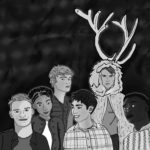NOTE: This post series may include spoilers from the Zaria Fierce Trilogy. If you hate spoilers, please read about the themes in Zaria Fierce after you have read the books.
The world of Zaria Fierce is full of folklore and myth, but there’s also a thread of Christianity through it as well. I focus heavily on non-human races and creatures and magic, but I also make it clear that while some species have long lives and/or magic they’re not gods. In fact, I would postulate that most of the characters, fantastical and human, are Christian, even those with magic, because none of them claim to be the Creator or ask to be worshipped… except the dragons.
The characters that are older – like Kafirr, Olaf, and Helena – lived back during the time of the Vikings. In the history of the Zaria Fierce world, this was also the time of the Dragomir Wars. It was the first time that multiple magical species got together to put a stop to the reign of dragons. They pooled their talents and got the job done; creating a prison to hold the dragons, a chain to bind and weaken them, a sword to master them, and an army to conquer them.
In the real world, Christianity was brought to Norway first by Haakon the Good, the youngest son of King Harald I Fairhair, in the 10th century, but his missionaries were resisted and Christianity failed to take hold. It was brought again by Olaf I Tryggvason, the great-grandson of Harald I, but his influence and ability to impose Christianity was limited to the areas directly under his control and gained little traction elsewhere. The true credit for converting Norway from paganism goes to Olaf II Haraldsson, who founded the Church of Norway in 1024 and established Christianity as the national religion. He later became the patron saint of Norway and was known as Olaf the Holy.
Due to this rich history, is it any wonder that many tales in Norwegian and Scandinavian folklore focus on paganism (represented by trolls) vs Christianity (the church)? Trolls try to get humans to tear down their churches because they cannot do it themselves and church bells are lethal to them. One such tale, is The Sailors and the Troll from The Troll With No Heart in His Body by Lise Lunge-Larsen. Without getting too philosophical or academic, I theorize that this is because trolls are in some respects considered unreal or powerless against true faith. In many ways, trolls in traditional folklore could be comparable to dragons in Zaria Fierce.
That said, I originally approached Zaria Fierce with the idea of a troll being the main villain, but this ended up changing as the story progressed and I learned more about Zaria and her world. Dragons appeared on the scene, and when they did the theme of forgiveness also came into play, changing not only my thoughts on trolls, but hopefully the reader’s thoughts as well. Trolls in Zaria Fierce can be capricious, belligerent, vicious, and cruel, but they can also be repentant, honorable, self-sacrificing, and kind. I loved that about them and I think readers will appreciate it, too. It’s very humanizing, and takes trolls out of the realm of fantasy and makes them relatable.
Christianity appears in other ways as well throughout the books. Zaria prays at various points. Hector and others acknowledge God in various phrases. The dwarves have a church. Hector, at times, expresses Christly attributes, and has a scene where he renews the spirit of his people. Zaria is tempted by the dragons in her trials against them, which is reminiscent of when Jesus is tempted in the wilderness. This is not to say that Zaria or Hector is Christ, they are not, it is to show that we can imbibe the Christly spirit and gather strength from it. Lastly, there’s the triumph of good over evil, light over darkness.
References:
Encyclopedia Britannica: Haakon the Good, Olaf I Tryggvason, Olaf II Haraldsson





